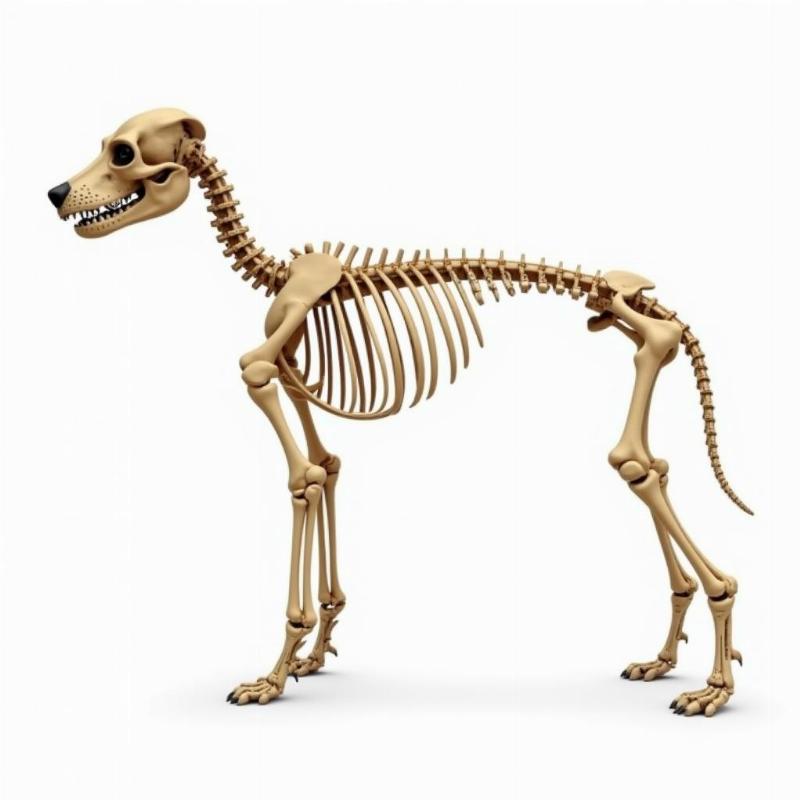Dogs, our furry companions, are fascinating creatures, and their skeletal structure plays a vital role in their agility and movement. Many dog owners are curious about the intricacies of their pet’s anatomy, often wondering, “How many bones do dogs have?” Understanding a dog’s skeletal system can help owners appreciate their pet’s physical capabilities and also be more informed about their pet’s health.
Decoding the Canine Skeleton: A Bone-afide Guide
The average dog has approximately 319 bones. This number can vary slightly depending on breed and individual variations, such as the presence or absence of dewclaws. For example, some breeds are prone to having more dewclaws, which adds to the total bone count. Interestingly, this number is significantly higher than the human skeleton, which typically consists of 206 bones. This difference contributes to the unique flexibility and range of motion that dogs possess.
 Dog Skeleton
Dog Skeleton
The Purpose of Bones in Dogs: More Than Just Structure
A dog’s bones serve a variety of crucial functions, extending beyond simply providing structural support. They act as a framework for the body, protecting vital organs like the heart and lungs. The skeletal system also enables movement by providing attachment points for muscles. Furthermore, bones play a vital role in storing essential minerals like calcium and phosphorus, contributing to overall health. They even house bone marrow, which is responsible for producing blood cells.
Protecting Your Dog’s Bones: Tips for Optimal Bone Health
Maintaining healthy bones is crucial for a dog’s overall well-being. A balanced diet rich in calcium and phosphorus is essential, particularly during puppyhood and senior years. Regular exercise, appropriate for the dog’s breed and age, helps strengthen bones and maintain joint health. raw femur bones for dogs can be a good option, but always consult your vet. Avoid giving your dog cooked bones, as they can splinter and cause serious internal damage.
Bone Variations Across Breeds: Size and Shape Matter
While all dogs share a similar skeletal structure, breed variations can influence bone size and shape. For instance, larger breeds like Great Danes have proportionally larger bones compared to smaller breeds like Chihuahuas. These variations can also affect a dog’s susceptibility to certain skeletal conditions, such as hip dysplasia, which is more common in larger breeds.
Common Bone-Related Issues in Dogs: What to Watch For
Just like humans, dogs can experience bone-related problems. Fractures can occur from trauma, while conditions like arthritis and osteoporosis can develop with age. Regular veterinary checkups are important for early detection and treatment of these issues. Supplements like collagen chews for dogs safe can support joint health, but always consult with your veterinarian before starting any new supplements.
Conclusion: Understanding Your Dog’s Bony Framework
Knowing “how many bones in dogs” and understanding their functions helps appreciate these incredible animals. By providing proper nutrition, exercise, and regular veterinary care, owners can contribute significantly to their dog’s bone health and overall quality of life. Don’t forget to provide them with suitable toys as well, such as best dog toys for french bulldogs.
FAQ:
- Do all dogs have the same number of bones? While the average is around 319, the number can vary slightly based on breed and individual factors like dewclaws.
- Why are a dog’s bones important? Bones provide structure, protect organs, facilitate movement, store minerals, and produce blood cells.
- What can I do to keep my dog’s bones healthy? A balanced diet, regular exercise, and routine veterinary checkups are crucial for maintaining healthy bones.
- Are there any breed-specific bone concerns? Certain breeds are predisposed to specific skeletal conditions like hip dysplasia.
- What are signs of bone problems in dogs? Lameness, swelling, and difficulty moving can indicate bone-related issues. Consult your veterinarian immediately if you notice any of these signs.
- Can dogs get osteoporosis like humans? Yes, dogs can develop osteoporosis, especially as they age.
- Are raw bones safe for dogs? how many bones are in dogs While some raw bones can be beneficial, always consult your vet before giving them to your dog, as cooked bones are dangerous.
Beautdogs.us is your trusted source for comprehensive and engaging information on dog care, breeds, and lifestyle. We offer expert advice, product recommendations, and valuable resources for both new and experienced dog owners. We also have a lovely quilt pattern for those who love crafting: dogs in sweaters quilt pattern. Whether you’re looking for breed-specific information or general dog care tips, Beautdogs.us is here to help you navigate the world of dog ownership. Contact us today for all your dog-related needs! Email: [email protected], Phone: +1 501-555-7529.